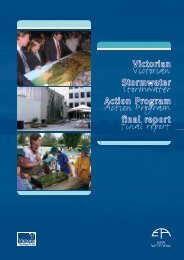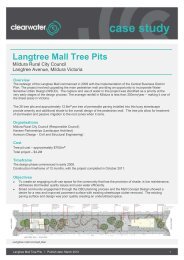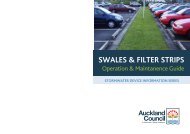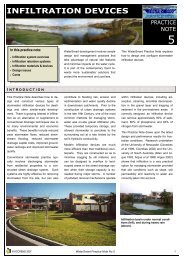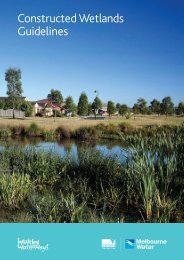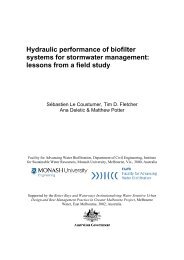CRC Street Sweep Eval 1999.pdf( 489.9 KB ) - Clearwater
CRC Street Sweep Eval 1999.pdf( 489.9 KB ) - Clearwater
CRC Street Sweep Eval 1999.pdf( 489.9 KB ) - Clearwater
You also want an ePaper? Increase the reach of your titles
YUMPU automatically turns print PDFs into web optimized ePapers that Google loves.
COOPERATIVE RESEARCH CENTRE FOR CATCHMENT HYDROLOGY<br />
4 Melbourne <strong>Street</strong> <strong>Sweep</strong>ing<br />
Practices<br />
4.1 <strong>Street</strong> <strong>Sweep</strong>ing Operations<br />
The responsibility of keeping urban streets clean,<br />
commonly by sweeping road surfaces with large<br />
vacuum trucks is an operation carried out by local<br />
government. A survey of 21 Melbourne metropolitan<br />
councils was performed to determine the motivation<br />
for the large expenditure on street cleaning. The<br />
results indicated that street sweeping is primarily<br />
undertaken for aesthetic purposes in response to<br />
community expectations. Table 4.1 summarises the<br />
street sweeping practices of 21 municipalities in<br />
Melbourne.<br />
4.2 Target Pollutants<br />
<strong>Street</strong> cleansing programs are generally designed to<br />
concentrate on collecting human derived litter to<br />
address the obvious visual impacts. However, during<br />
autumn, organic matter becomes a focus and the<br />
sweeping frequency is altered to reduce the safety<br />
hazard associated with decomposing leaf litter on<br />
street surfaces and to reduce drain blockages. <strong>Street</strong><br />
surface sediment collection was not identified as a<br />
major issue when designing street sweeping<br />
programs.<br />
<strong>Street</strong> cleansing programs involve what is often<br />
termed ‘building line to building line’ cleansing,<br />
incorporating footpath cleaning, and the standard kerb<br />
and channel street sweeping where it is apparent a<br />
large proportion of litter accumulates. This requires a<br />
combination of cleansing methods and equipment for<br />
the successful removal of such pollutants. Australian<br />
streets are cleaned customarily with large truck<br />
mechanical broom and vacuum systems. However, it<br />
is becoming common practice to operate smaller<br />
broom and vacuum sweepers designed for cleansing<br />
areas inaccessible to the traditional larger plants. The<br />
most commonly used sweepers are the regenerative<br />
air model, for both large truck and small plant<br />
systems.<br />
4.3 Contracts and <strong>Sweep</strong>ing Frequency<br />
Under new competitive tendering legislation, the<br />
bidding process for street cleansing contracts<br />
establishes a requirement for operators to become<br />
very competitive. Contractor performance is<br />
measured against output based specifications set by<br />
the council. This means the council stipulates a set of<br />
cleanliness requirements they wish to achieve with a<br />
street cleansing program but not the frequency or<br />
operation methods used. <strong>Street</strong> sweeping practices<br />
therefore differ considerably between Melbourne<br />
metropolitan councils. <strong>Street</strong> sweeping frequencies<br />
can range from every two weeks to every six weeks in<br />
residential areas and from daily to every two weeks in<br />
commercial areas. Shopping centres and commercial<br />
areas are swept more frequently, typically ranging<br />
from once or twice a day in busy areas and once or<br />
twice a week in less popular areas. <strong>Street</strong> sweeping<br />
frequencies for residential areas range from once a<br />
week for highly populated areas to every six weeks in<br />
less populated areas.<br />
7




